Sat 16 Jul 2016
Available from Stark House Press, Amazon, Walmart and at PulpFest 2016.
Sat 16 Jul 2016
Available from Stark House Press, Amazon, Walmart and at PulpFest 2016.
Sat 16 Jul 2016
LOUIS L’AMOUR “Unguarded Moment.” First appeared in Popular Detective, March 1952. Collected in The Hills of Homicide (Bantam, paperback, 1983).
The first paragraph caught my attention:
The second really had me sitting up and taking notice:
And the third had me hooked all the way:
But of course he was seen, and therein lies the story. It continues with some petty blackmail, an accidental death, the dead man’s girl friend who wants to …
This is Cornell Woolrich territory, maybe with clearer and simpler language, but pure noir from beginning to end.
Fri 15 Jul 2016
TENSION. MGM, 1949. Richard Basehart, Audrey Totter, Cyd Charisse, Barry Sullivan, Lloyd Gough, William Conrad. Written by Alan Rivkin and John Klorer. Directed by John Berry.
A neat, twisty little noir that comes close to perfection.
Willard Quimby (Richard Basehart) starts out as the bespectacled night manager of an all-night L.A. drugstore, back in the days when every drugstore had a soda fountain, a tube-tester, a cigar humidor and the latest out-of-town newspapers. And I have to say right at the start that photographer Harry Stradling and art director Leonid Vasian make this place come alive with a wealth of detail captured in sharp, deep-focus photography: the perfect real-life backdrop for the characters who live in it.
We quickly learn that Willard’s wife Claire (Audrey Totter) seems to be trying for the title of Town Tramp in the Greater Los Angeles Metropolitan Area, blatantly cheating on him (with a surprising frankness for an MGM film of this period) and belittling him every chance she gets. Nonetheless, he loves her and reacts with dog-like devotion to every crumb of scorn she tosses at him.
Well we’ve all had relationships like that, haven’t we? But when she moves in with showy Barney Dauger (Lloyd Gough), Warren is devastated. Distraught, he shows up at Barney’s beach house and gets in a scuffle with Barney, who knees him in the crotch (another unexpected moment for a 1949 MGM movie) and leaves him writhing humiliated in the sand in front of his unfaithful wife.
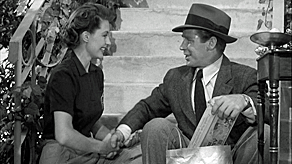
Someone said something clever once about a little man scorned, but I forget what it was. In any event, it prompts Willard to murder, and he conceives a brilliant/half-baked scheme to get away with it; he gets contact lenses and assumes a secret identity: Paul Sothern, a traveling salesman staying weekends at a nice apartment complex and occasionally phoning threats to Daeger, making sure to leave his name. His thinking is that when he-as-Sothern murders Daeger, Sothern can simply disappear, leaving him safe as Warren Quimby.

What he doesn’t count on is that his role as Paul Sothern will be much more enjoyable than his life as Quimby. He even meets a pretty neighbor (Cyd Charisse) at his new apartment complex, they feel drawn to each other, and for a while he considers just forgetting about the whole murder thing and making a good life with a nice girl who loves him. But then he remembers his humiliation and steels his resolve to throw away this chance for happiness and make a mess of things.
Which is when the twists and turns come in and things get interesting.
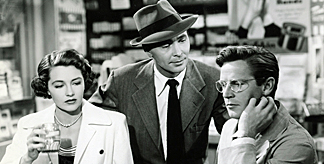
I won’t reveal anything from here on out, except to note that Tension proves to be a very apt title indeed. Barry Sullivan and William Conrad make an intriguing pair of homicide cops, especially as Sullivan seems more interested in putting the make on Audrey Totter than anything else. Writers Rivkin and Klorer provide a fair share of dramatic surprises, and director Berry maintains the atmosphere without sacrificing pace.
I should also add that a few minutes after THE END flashes on the screen and you smile with satisfaction, you may find yourself saying, “Hey, wait a minute; why did….?†Or “How come they didn’t…?†I know I did. But on looking back a third time I had to admit it all makes for engrossing viewing even when logic takes a holiday.
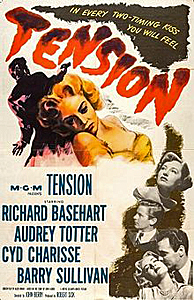
Fri 15 Jul 2016
AGATHA CHRISTIE – Murder at Christmas. Dodd Mead, hardcover, 1939. Originally published in the UK as Hercule Poirot’s Christmas (Collins, hardcover, 1939). Reprinted many times, including under the title A Holiday for Murder.
What could be a better book to read on a flight from Detroit to Los Angeles than a beat-up copy of an good old-fashioned Hercule Poirot murder mystery? None I can think of, I say, and that it’s a locked room mystery is only icing on the cake.
And why murder at Christmas? Let M Poirot tell us:
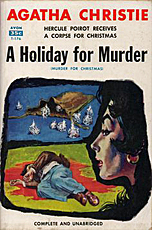
Dead with his throat cut is an old man who has been disappointed in his offspring and has told them just that only hours before. He also told them, with deliberate malice, that he intends to change his will immediately after Christmas. But does he live that long? You should know better than to ask.
Here’s the problem, though. The door to the dead man’s room is locked from the inside and must be broken down to get to him, and the windows do not open. The servants cannot have done it and there is no homicidal maniac on the loose anywhere around. It must be one of the family, but which one? And how?
Poirot claims the solution must come from the personalities of each of the possible suspects, and even more importantly that of the victim himself. How true! Any reader who dares to ignore such a challenge to the reader will make absolutely no headway in solving this case before Poirot does, and even then, only those readers who are already familiar with the tricks that Agatha Christie invariably had up her sleeve will stand a chance. As for myself, I have given up trying. To my mind, this is an amazing piece of work.
One thing still puzzles me though. The story does take place over the course of seven days between December 22nd through the 28th, but besides the gathering together of the old man’s sons and their wives, plus a surprise guest or two, there are no festivities planned, no grand meals, no decorations, no gifts, no snow, none of the usual Yuletide trappings. The story is fine without them, but I kind of missed them.
Thu 14 Jul 2016
Two songs from this country rock band’s 1972 album Rootin’.
Thu 14 Jul 2016

DAVID FROME – The Black Envelope. Farrar & Rinehart, hardcover, 1937. Popular Library, paperback, circa 1965. Published in the UK as The Guilt Is Plain, Longmans Green & Co., hardcover, 1938.
That timid detective manqué, Evan Pinkerton, is in Brighton for the first time in fifteen years to enjoy the seashore. What he gets is foul weather — and foul play at the Royal Pavilion, where someone, probably part of her household sticks a knife in the odious Mrs. Isom.
Lots of coincidence here, not least of which is the presence of Inspector Bull in Brighton at the time the murder takes place. Once he finds out what “take it on the lam” means, Mr. Pinkerton takes it, loses his clothes, and finally has to admit he was on the scene when the murder took place.
Frome (aka Leslie Ford) writes well. Once you’ve adjusted to the coincidences and Pinkerton’s being not just rabbity but virtually hag-ridden at the beginning, you can enjoy a complex fair-play mystery.
Thu 14 Jul 2016
RUTHE FURIE – A Natural Death. Avon, paperback original; 1st printing, January 1996.
This is the second of only three cases on record for female private eye Fran Tremaine Kirk, as she introduces herself. Both the first one, If Looks Could Kill (1995), and this one were nominated for Shamus awards. The third was A Deadly Pate (1996), and that was the end of the series.
This particular case begins with a death by pitchfork impalement at an organic farm somewhere in the Buffalo NY area, and widens to a totally dysfunctional family, lots of secrets, vandalized computers, a hotel burned to the ground (in which Fran is presumed to have been staying), a young missing girl with plenty of growing pains, a sheriff with competency issues and another murder.
Fran Kirk also is having problems with the new man in her life, perhaps having to do with the first that her first husband was a wife-abuser. She’s also a member of a support group for women in similar situations, and one of the other member of the group was a “very close” friend of the first dead man.
All of this makes for a very long book, over 280 pages, and even more detrimental to the story is that none of the characters — and there are a lot of them — are particularly likeable. Well, yes, I know, characters in mystery stories don’t have to be likeable, but they have to be interesting enough in their bad habits to care what happens to them. This one didn’t make the grade with me.
Wed 13 Jul 2016
CHARLIE CHAN AT THE WAX MUSEUM. 20th Century Fox, 1940. Sidney Toler, Victor Sen Yung, C. Henry Gordon, Marc Lawrence, Joan Valerie, Marguerite Chapman, Ted Osborne. Based on the character created by Earl Derr Biggers. Director: Lynn Shores.
There are enough plot holes in the movie that not even a top-notch police detective from Honolulu could easily solve. And it’s true that the acting talents on display here aren’t all that memorable. But Charlie Chan at the Wax Museum is nonetheless a spunky little programmer and, in my estimation, a particularly well photographed entry in the Charlie Chan series. The art direction is likewise top notch and serves the film well.

The plot: Notorious gangster Steve McBirney (Marc Lawrence) escapes from police custody and seeks refuge at a crime-themed wax museum. The proprietor, Dr. Cream (C. Henry Gordon), who doubles as a plastic surgeon capable of giving escaped convicts new faces, invites Charlie Chan (Sidney Toler) to the museum.
Although he and McBirney (Lawrence) are plotting Chan’s demise, he cajoles Chan to visit to take part in a live radio broadcast where Chan and Dr. Otto Von Brom (Michael Visaroff) can debate a controversial past criminal case.
So, on a dark and stormy night, Chan and a hodgepodge crew arrive at the museum for the broadcast. Among them are an intrepid reporter, Mary Bolton (Marguerite Chapman); a radio announcer and his broadcast assistant; Dr. Cream’s assistant; and an attorney. Things seem to be going okay for the group. That is until someone cuts the lights (of course they do!) and Dr. Von Brom ends up dead.
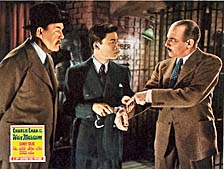
It’s then up to Chan, along with bumbling son Jimmy (Sen Yung) to solve the mystery. Who killed Von Brom and why? Was it McBirney, who is hiding out in the museum? Or maybe one of the wax dummies isn’t a dummy after all and is really alive? Or could it be someone else?
As I mentioned earlier, there are more than a couple of plot holes in the story. Still, it’s not so much the destination as the journey itself that makes the movie worth a look. What struck me watching Charlie Chan and the Wax Museum is how much the Charlie Chan universe has its own particular rules that guide how both criminals and frightened individuals behave.
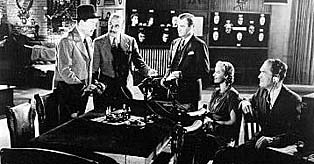
When it comes time for Chan to solve a crime, for instance, he somehow is able to gather all the suspects in the same room with a mere wave of his hand, which may or may not be holding a small pistol. Suspects cower on cue and they nearly always comply with his commands.
And despite the vicious crimes committed on or partially off screen, the Charlie Chan cinematic universe is a rather innocent world in which the players simply don’t ever come across as truly evil. Perhaps this partially explains why the Charlie Chan universe simply was no longer palatable to cinema-goers in the wake of the Second World War. Soon enough, seedy neon lit bars and dingy hotel rooms would replace wax museums and circuses as the predominant locales of far more cynical crime stories in what would later be termed film noir.
Tue 12 Jul 2016
DARK STREETS OF CAIRO. Universal Pictures, 1940. Sigrid Gurie, Ralph Byrd, Eddie Quillan, George Zucco, Katherine DeMille, Rod La Rocque, Sig Arno, Yolande Mallott, Lloyd Corrigan, Nestor Paiva. Director: László Kardos.
A very minor crime thriller taking place in Egypt (of course) in which the comedy relief takes up nearly as much playing time as does the story itself, that of a gang of crooks anxious to get their hands on a set of seven jewels dug up in a pharaoh’s tomb by an American archaeological expedition.
Stealing the show from beneath the nominal hero, Ralph Byrd, is of course George Zucco as the ruthless head of the bad guys. The rest of the players are all along for the ride, including Eddie Quillan as Byrd’s goofy sidekick, Jerry Jones. Lots of secret doors and underground passages, eyes looking out from a mummy case, a knife-throwing act, and a trio of good-looking women, but nothing that would give this film more than a luke-warm recommendation from me.
On second thought, that may be too harsh. I did watch it all the way through. That always counts for something.
Tue 12 Jul 2016

CATHERINE DAIN – Sing a Song of Death. Jove, paperback original; 1st printing, March 1993.
This is the second of seven recorded cases of Reno-based private eye Freddie O’Neal, all published as paperback originals between 1992 and 1997. This is back in the day when female mystery writers who wrote for the paperback trade did not have to write cozies, with series characters ranging from fudge makers to herbal shop owners to mediums with crystal balls and other assorted outré accoutrements.
That Catherine Dain (in real life author Judith Garwood) wrote a series of PI novels instead does not make them — or rather, at least this one — more than Sue Grafton-lite, however. Freddie, who is tall and definitely shies away from romantic relationships, works as a bodyguard to a Lake Tahoe lounge singer in this one, but the case is cluttered with too many friends, family members and possible suspects when the singer is found dead anyway — few of whom are particular likable.
It’s only when Freddie survives an attack on her life that the story picks up any speed, only to be done in by an ending that could best be described as mediocre, with the only interesting character other than Freddie murdered on a set of courthouse steps, his death apparently going unchallenged.